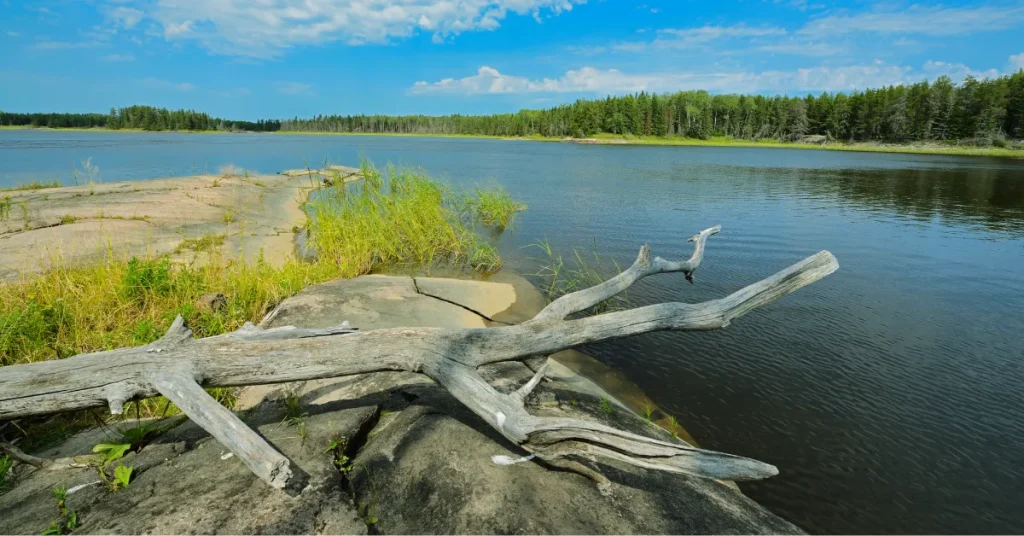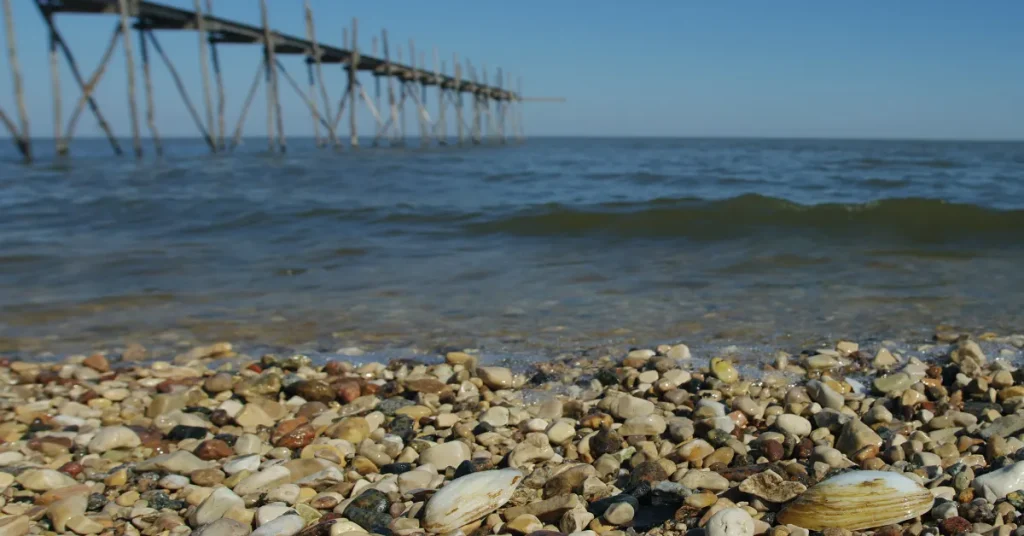Lake Winnipeg reaches a maximum depth of about 36 meters. The average depth of this expansive lake is roughly 12 meters.
Lake Winnipeg, located in the heartland of Manitoba, Canada, is a freshwater giant often sought out by visitors for its recreational offerings and natural beauty.
It ranks as the sixth-largest freshwater lake in Canada and stands as an important ecological and economic resource.
Outdoor enthusiasts and nature lovers are drawn to its vast waters for fishing, boating, and sightseeing.
Environmental researchers also study its complex ecosystem, which supports a diverse range of wildlife. With numerous rivers and streams feeding into it, Lake Winnipeg serves as a watershed critical for maintaining regional biodiversity.

Plumbing The Depths Of Lake Winnipeg
Plumbing the Depths of Lake Winnipeg invites intrigue and awe. This vast body of freshwater, nestled in the heart of Canada, is not only majorly significant for its ecological diversity but also for its impressive dimensions.
Let’s dive into the world beneath its waves to discover just how deep Lake Winnipeg truly is.
Geographic And Hydrographic Features
Lake Winnipeg is a geological wonder. Stretching over 24,514 square kilometers, it stands as the sixth-largest freshwater lake in Canada. The lake features a variety of depths, shaped by its complex underwater topography.
The northern basin is significantly deeper than the southern, creating unique environments for marine life.
- Northern basin: Deeper with rocky, uneven terrain
- Southern basin: Shallower with sedimentary beds
Lake Winnipeg’s deepest point reaches approximately 118 feet, a striking contrast to its shallower shores.
Measuring Techniques And Technologies
Experts utilize cutting-edge equipment to explore this aquatic landscape. Sonar technology, alongside GPS, anchors their efforts, providing precise depth readings.
Research vessels equipped with echo-sounders send sound waves to the lakebed. These waves bounce back, revealing depth details.
| Technology | Use |
| Sonar Devices | Map underwater topography |
| GPS Systems | Position accuracy on lake surface |
| Echo-sounders | Calculate depth by sound wave reflection |
Lake Winnipeg In Numbers

Lake Winnipeg is not just a body of water; it’s a natural wonder in Manitoba, Canada, with its own story told through numbers. These figures reveal the lake’s physical dimensions.
They allow us to appreciate its size and depth better. Explore the vital statistics of Lake Winnipeg here.
Average And Maximum Depth Figures
Lake Winnipeg stretches vast and deep.
On average, its waters cover a depth of 12 meters (39 feet).
Yet, in certain spots, it plunges much deeper.
The maximum depth recorded is about 36 meters (118 feet).
Comparative Analysis With Other Lakes
When we line up Lake Winnipeg against other lakes, its uniqueness stands out.
- Lake Superior, the largest of the Great Lakes, reaches depths of 406 meters (1,333 feet).
- Lake Manitoba, a neighbor, has a shallower basin with depths at roughly 7 meters (23 feet).
- Great Slave Lake, in Canada’s Northwest Territories, dwarfs many with a maximum depth of 614 meters (2,014 feet).
In such comparisons, Lake Winnipeg holds its own, showing a respectable depth amidst Canada’s extensive network of freshwater lakes.
Ecosystems Below The Surface
Lake Winnipeg, a majestic freshwater giant, hides a world teeming with life beneath its waves.
This sprawling body of water, renowned as one of Canada’s largest lakes, boasts a remarkable depth which plays host to a diverse array of underwater ecosystems. Here, we delve into the life that thrives below the surface.
Native Aquatic Species
The depths of Lake Winnipeg foster a habitat for a rich variety of native species. This includes an impressive lineup of fish such as walleye, northern pike, and yellow perch.
Not to mention the countless microorganisms that form the base of this aquatic food web. Let’s look at some of these vital underwater inhabitants:
- Walleye: Often found gliding through the cooler, deeper waters
- Northern Pike: A predator lurking amidst the lake’s foliage
- Yellow Perch: Schooling in the shallows, flashing their vibrant stripes
Impacts Of Depth On Lake Biodiversity
The varied depths of Lake Winnipeg are crucial to maintaining its biodiversity. Shallower areas warm up quickly and are ideal for perch and bass, while deeper, cooler regions are preferred by species such as the burbot. Here’s how depth influences the lake’s ecosystem:
| Depth Range (meters) | Typical Conditions | Affected Species |
| 0-5 | Warm, light-rich | Small fish, algae |
| 5-10 | Moderate temperature | Walleye, pike |
| 10+ | Cooler, less light | Burbot, deep-water species |
The depths of Lake Winnipeg are more than just a measure; it’s a dynamic feature that shapes the very core of life within its waters.
Historical Mysteries And Shipwrecks

Lake Winnipeg harbors tales that transcend its sheer size. Among them, stories of historical mysteries and shipwrecks stir the imagination.
For adventurers and historians alike, the lake’s murky depths offer a treasure trove of secrets, with many hoping to uncover what lies beneath its waves.
Legends Of Submerged Artifacts
Deep within Lake Winnipeg, legends tell of hidden relics from the past. Rumors of artifacts trapped underwater spark endless curiosity.
Some believe these items belong to lost civilizations, while others speculate about ancient trading goods that never reached their destinations. Divers and historians join forces, seeking to unlock the lake’s enigmatic past.
- Buried canoes from fur trading eras
- Glints of gold rumored to be scattered across the lakebed
- Stone tools dating back centuries
Discoveries From The Deep
The lake has indeed yielded astonishing finds. Sunken boats tell tales of fierce storms and navigational errors. Items drawn from the abyss serve as puzzles pieces of history.
These artifacts provide precious insights into the lives of people who lived and worked along these waters.
| Year | Discovery | Significance |
| 1997 | Steamship remains | Insights into 19th-century transportation |
| 2008 | Early settler artifacts | Glimpse into pioneer life |
| 2015 | Native American pottery shards | Connection to ancient cultures |
Each item lifted from the lake sparks more questions than answers, urging the quest further. What else remains hidden in Lake Winnipeg’s vast waters? Only time and relentless exploration will tell.
Human Impact And Conservation Efforts
Lake Winnipeg is a natural wonder, treasured for its vast size and ecological importance. Yet, human activity has altered its waters.
This has prompted urgent conservation efforts. Let’s explore the human impact and the steps taken to protect this majestic lake.
Threats To The Lake’s Depth And Health
- Pollution: Runoff containing chemicals affects water levels and quality.
- Industrial Activities: They lead to sediment and harmful substances entering the lake.
- Climate Change: Results in unpredictable water level changes.
- Invasive Species: Disrupt the natural ecosystem, impacting the lake’s health.
Active Preservation Initiatives
Preservation initiatives play a pivotal role in safeguarding Lake Winnipeg’s future. Here are key actions taken:
| Action | Description |
| Reducing Pollutants | Efforts to lessen farm and city runoff. |
| Regulating Fisheries | Ensures sustainable fish populations. |
| Habitat Restoration | Improves conditions for native species. |
| Public Awareness | Education about the lake’s importance. |
- Supporting research for ecological balance.
- Collaborating with Indigenous communities.
Active participation and thoughtful stewardship are the keys. With a united effort, we can secure a thriving future for Lake Winnipeg.
FAQs About How Deep Is Lake Winnipeg
What Is The Average Depth Of Lake Winnipeg?
The average depth of Lake Winnipeg is approximately 12 meters (39 feet). This relatively shallow depth is spread across its vast area.
How Deep Is Lake Winnipeg At Its Deepest Point?
Lake Winnipeg reaches its deepest point at about 36 meters (118 feet). This deepest spot is known as the ‘Narrows,’ where the north and south basins meet.
Does Lake Winnipeg Have Varying Depth Levels?
Yes, the depth of Lake Winnipeg varies, with a shallow south basin and a deeper north basin. The variable depth affects the lake’s ecology and marine life.
What Factors Affect The Depth Of Lake Winnipeg?
Sedimentation, water extraction, and climate conditions contribute to changes in Lake Winnipeg’s depth. These factors lead to depth variations throughout the year.
Conclusion
Exploring Lake Winnipeg reveals its staggering depths, reaching up to 36 meters at its deepest point. Whether you’re an avid angler or a curious explorer, its waters hold a wealth of natural marvels.
Remember, Lake Winnipeg’s depth makes it not just a geographical wonder, but an ecological treasure trove, too.
Safe travels on your next watery adventure!
Resources:
1. https://earthobservatory.nasa.gov/images/151918/emerald-swirls-of-algae-in-lake-winnipeg
